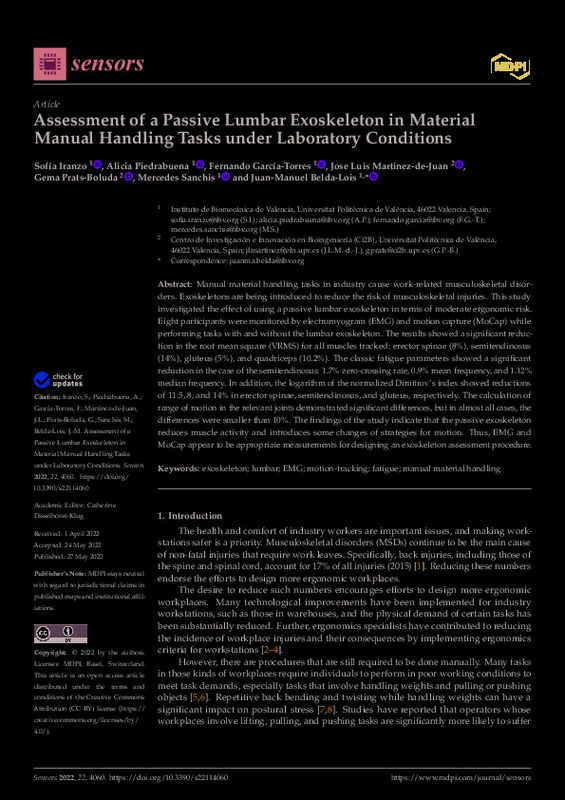JavaScript is disabled for your browser. Some features of this site may not work without it.
Buscar en RiuNet
Listar
Mi cuenta
Estadísticas
Ayuda RiuNet
Admin. UPV
Assessment of a Passive Lumbar Exoskeleton in Material Manual Handling Tasks under Laboratory Conditions
Mostrar el registro sencillo del ítem
Ficheros en el ítem
| dc.contributor.author | Iranzo-Egea, Sofía
|
es_ES |
| dc.contributor.author | Piedrabuena Cuesta, Alicia
|
es_ES |
| dc.contributor.author | García-Torres, Fernando
|
es_ES |
| dc.contributor.author | Martínez-de-Juan, José L.
|
es_ES |
| dc.contributor.author | Prats-Boluda, Gema
|
es_ES |
| dc.contributor.author | Sanchís Almenara, Mercedes
|
es_ES |
| dc.contributor.author | BELDA LOIS, JUAN MANUEL
|
es_ES |
| dc.date.accessioned | 2023-05-11T18:01:55Z | |
| dc.date.available | 2023-05-11T18:01:55Z | |
| dc.date.issued | 2022-06 | es_ES |
| dc.identifier.uri | http://hdl.handle.net/10251/193269 | |
| dc.description.abstract | [EN] Manual material handling tasks in industry cause work-related musculoskeletal disorders. Exoskeletons are being introduced to reduce the risk of musculoskeletal injuries. This study investigated the effect of using a passive lumbar exoskeleton in terms of moderate ergonomic risk. Eight participants were monitored by electromyogram (EMG) and motion capture (MoCap) while performing tasks with and without the lumbar exoskeleton. The results showed a significant reduction in the root mean square (VRMS) for all muscles tracked: erector spinae (8%), semitendinosus (14%), gluteus (5%), and quadriceps (10.2%). The classic fatigue parameters showed a significant reduction in the case of the semitendinosus: 1.7% zero-crossing rate, 0.9% mean frequency, and 1.12% median frequency. In addition, the logarithm of the normalized Dimitrov's index showed reductions of 11.5, 8, and 14% in erector spinae, semitendinosus, and gluteus, respectively. The calculation of range of motion in the relevant joints demonstrated significant differences, but in almost all cases, the differences were smaller than 10%. The findings of the study indicate that the passive exoskeleton reduces muscle activity and introduces some changes of strategies for motion. Thus, EMG and MoCap appear to be appropriate measurements for designing an exoskeleton assessment procedure. | es_ES |
| dc.description.sponsorship | This study was funded by Fundacion Prevent. | es_ES |
| dc.language | Inglés | es_ES |
| dc.publisher | MDPI AG | es_ES |
| dc.relation.ispartof | Sensors | es_ES |
| dc.rights | Reconocimiento (by) | es_ES |
| dc.subject | Exoskeleton | es_ES |
| dc.subject | Lumbar | es_ES |
| dc.subject | EMG | es_ES |
| dc.subject | Motion-tracking | es_ES |
| dc.subject | Fatigue | es_ES |
| dc.subject | Manual material handling | es_ES |
| dc.subject.classification | TECNOLOGIA ELECTRONICA | es_ES |
| dc.subject.classification | INGENIERIA MECANICA | es_ES |
| dc.title | Assessment of a Passive Lumbar Exoskeleton in Material Manual Handling Tasks under Laboratory Conditions | es_ES |
| dc.type | Artículo | es_ES |
| dc.identifier.doi | 10.3390/s22114060 | es_ES |
| dc.rights.accessRights | Abierto | es_ES |
| dc.contributor.affiliation | Universitat Politècnica de València. Escuela Técnica Superior de Ingeniería del Diseño - Escola Tècnica Superior d'Enginyeria del Disseny | es_ES |
| dc.contributor.affiliation | Universitat Politècnica de València. Escuela Técnica Superior de Ingenieros Industriales - Escola Tècnica Superior d'Enginyers Industrials | es_ES |
| dc.description.bibliographicCitation | Iranzo-Egea, S.; Piedrabuena Cuesta, A.; García-Torres, F.; Martínez-De-Juan, JL.; Prats-Boluda, G.; Sanchís Almenara, M.; Belda Lois, JM. (2022). Assessment of a Passive Lumbar Exoskeleton in Material Manual Handling Tasks under Laboratory Conditions. Sensors. 22(11):1-29. https://doi.org/10.3390/s22114060 | es_ES |
| dc.description.accrualMethod | S | es_ES |
| dc.relation.publisherversion | https://doi.org/10.3390/s22114060 | es_ES |
| dc.description.upvformatpinicio | 1 | es_ES |
| dc.description.upvformatpfin | 29 | es_ES |
| dc.type.version | info:eu-repo/semantics/publishedVersion | es_ES |
| dc.description.volume | 22 | es_ES |
| dc.description.issue | 11 | es_ES |
| dc.identifier.eissn | 1424-8220 | es_ES |
| dc.identifier.pmid | 35684682 | es_ES |
| dc.identifier.pmcid | PMC9185583 | es_ES |
| dc.relation.pasarela | S\466176 | es_ES |
| dc.contributor.funder | Fundación Prevent | es_ES |
| dc.subject.ods | 03.- Garantizar una vida saludable y promover el bienestar para todos y todas en todas las edades | es_ES |
| dc.subject.ods | 08.- Fomentar el crecimiento económico sostenido, inclusivo y sostenible, el empleo pleno y productivo, y el trabajo decente para todos | es_ES |
| dc.subject.ods | 09.- Desarrollar infraestructuras resilientes, promover la industrialización inclusiva y sostenible, y fomentar la innovación | es_ES |








